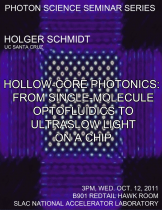Speaker: Holger Schmidt, UC Santa Cruz
Program Description
Non-solid media make up a large part of our environment, but are not commonly incorporated in integrated photonic systems due to the refractive index mismatch that prevents the use of conventional waveguiding techniques found in telecommunications and optoelectronics.
In order to guide light through liquids and gases, new approaches for confining electromagnetic radiation in low-index media are needed. I will describe the development of an integrated photonic platform based on hollow-core antiresonant reflecting optical waveguides (ARROWs).
Using this approach, versatile photonic components and structures can be designed that open new areas for chip-based photonics. As a first example, I will discuss detection and manipulation of single particles in liquid-filled, optofluidic devices. Secondly, I will review the realization of a new chip-scale atom photonics platform which allows for observation of large quantum interference effects in alkali vapors, including world-record slow light propagation on a chip.





